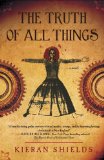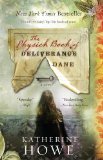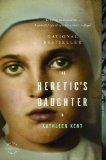Summary | Excerpt | Reviews | Beyond the book | Read-Alikes | Genres & Themes | Author Bio

A Novel
by Kieran Shields"The past, once it slips beyond living memory, becomes a sort of graveyard. It's easy to see no more than a collection of names and dates, etched in stone, receding into obscurity. I've always relished the look and feel of graveyards: the solitude, the grim elegance, and a hint of something more. A glance across rows of headstones and the eyes land on a freestanding tomb. Then comes that morbid, gleeful little voice, a curious whispering faint among the rustling leaves: "What do you suppose is in there?" - Literary Grave Robbing in The Truth of All Things by Kieran Shields
In recent years, "borrowing" and the creative fusing of different genres have become all the rage. Whether earlier songs melded with new beats (hitting mainstream audiences in the television show, Glee, for example); classic stories retold with a twist, like the "mashup" Pride and Prejudice and Zombies; or childhood personalities repurposed for older audiences (My Little Pony, is a popular example); everything, it seems, is ripe for the picking.
Kieran Shields's novel, The Truth of All Things, is one literary fusion that's a real treat for readers. It is hard to neatly categorize this novel, and I think to do so would be to miss out on the riches of Shields's storytelling. At once a literary novel and a work of historical fiction, this book is also equal parts great mystery and page-turning gothic thriller. Shields introduces readers to an interesting and fun new partnership in crime-solving: Archie Lean and Perceval Grey.
Set in the summer of 1892, the story opens with the gruesome murder of a young prostitute in Maine's waterfront city of Portland. Assigned to solve this crime is newly appointed Deputy Marshal Archie Lean, a family man hoping to do well in his police career. Doctor Virgil Steig is the coroner on site, a thorough and thoughtful man who, given the scope of this crime, calls in a talented but quirky former private investigator: Perceval Grey. In contrast to Lean, Grey's skills of observation are unmatched. He is regimented, calculating and astute. While not thrilled with working together at first, Lean and Grey forge, if not a fast friendship, a respect for each other's methods of investigation.
Through clues left at the crime scene, the partners determine that a serial killer, possibly of a psychotic and deranged predisposition, is on the loose. Dogged digging reveals a possible connection to both the Salem Witch Trials of 1692 and a tribe of Native American Abenaki Indians. Coincidentally, Perceval Grey is half-Abenaki, and his knowledge of the old and mostly out-of-use language proves very helpful to the case. As more information is uncovered by the pair, the story gets deeper and creepier. Along the way, Dr. Steig continues to lend his help, and his curious niece, Helen Prescott, throws herself into the investigative fold. Prescott works as a research historian at the library and has a nose for mystery.
Shields has, quite successfully, developed some interesting characters. While Lean and Grey are the stars of the show, the supporting characters are equally engaging and important. However there are a few (very minor) issues that gave me momentary pause while reading. In the first part of the novel, there are instances of overwriting, which are unnecessary to the advancement of the story. It is clear Shields compiled a lot of research in the preparation and writing of The Truth of All Things, but I wonder if he tried to cram too much information into the plot. While he does a good job creating vivid imagery of his characters as well as setting various scenes (the city, cemetery, library, morgue, crime scenes, etc), the over-embellished sections draw attention to the effort of writing rather than keep the reader engaged in the story.
In addition to a brief, wobbly scene about 80% of the way through, my final quibble - which, admittedly, is somewhat negligible though still worth noting - has nothing to do with the story at all. Regardless of what the old adage says, I think a lot of people do judge a book by its cover but, in this instance, they shouldn't. It isn't attractive, and it simply doesn't serve the story well.
Overall, however, I am so pleased with Shields's novel, and I find it to be a very strong debut. I feel like I went on the adventure with Lean and Grey, and I have already recommended the book to friends and family. At times, it was absolutely unputdownable.
Given its seasonal setting, The Truth of All Things makes an excellent choice for a summer or vacation read. Shields seems to have set up his story to continue the partnership of Lean and Grey in a sequel, if not a series, and I am as excited about this prospect as I am of a new Jo Nesbø novel. I look forward to reading much more from the talented Kieran Shields.
![]() This review was originally published in The BookBrowse Review in April 2012, and has been updated for the
February 2013 edition.
Click here to go to this issue.
This review was originally published in The BookBrowse Review in April 2012, and has been updated for the
February 2013 edition.
Click here to go to this issue.

If you liked The Truth of All Things, try these:

The Physick Book of Deliverance Dane
by Katherine Howe
Published 2010
A spellbinding, beautifully written novel that moves between contemporary times and one of the most fascinating and disturbing periods in American history - the Salem witch trials.

by Kathleen Kent
Published 2009
Martha Carrier was one of the first women to be accused, tried and hanged as a witch in Salem, Massachusetts. The Heretic's Daughter tells her story; a haunting portrait, not just of Puritan New England, but also of one family's deep and abiding love in the face of fear and persecution.
Your guide toexceptional books
BookBrowse seeks out and recommends the best in contemporary fiction and nonfiction—books that not only engage and entertain but also deepen our understanding of ourselves and the world around us.